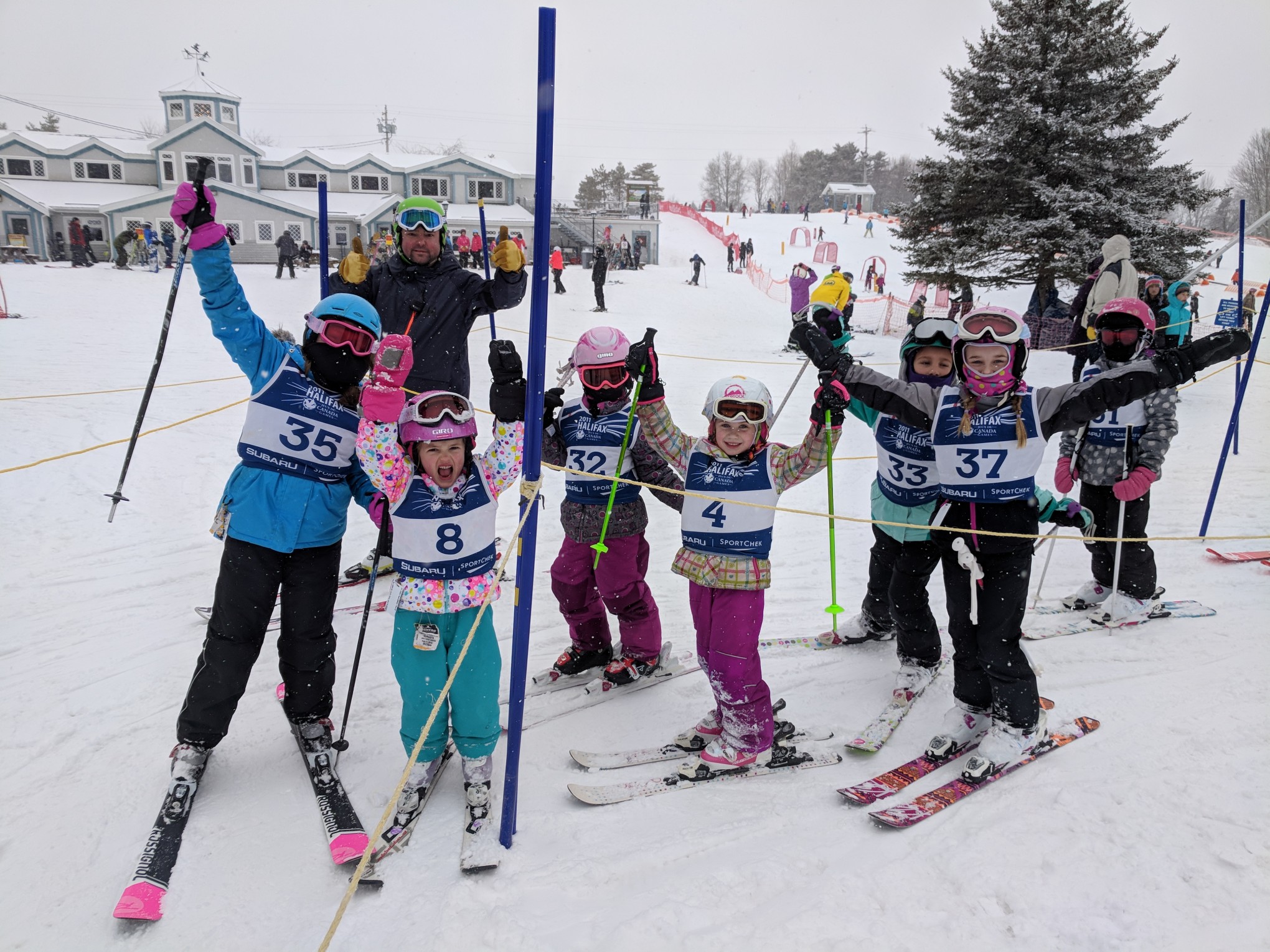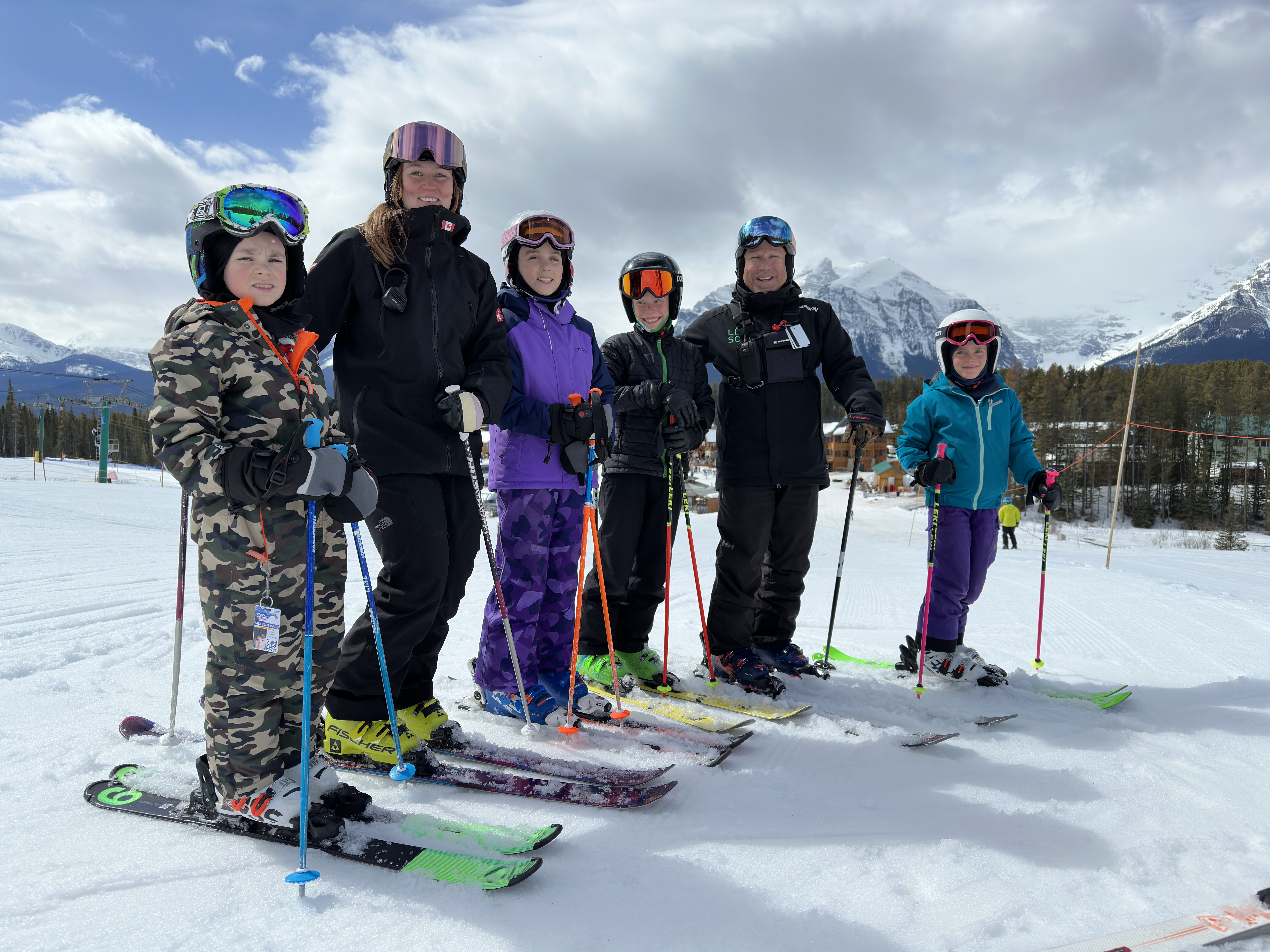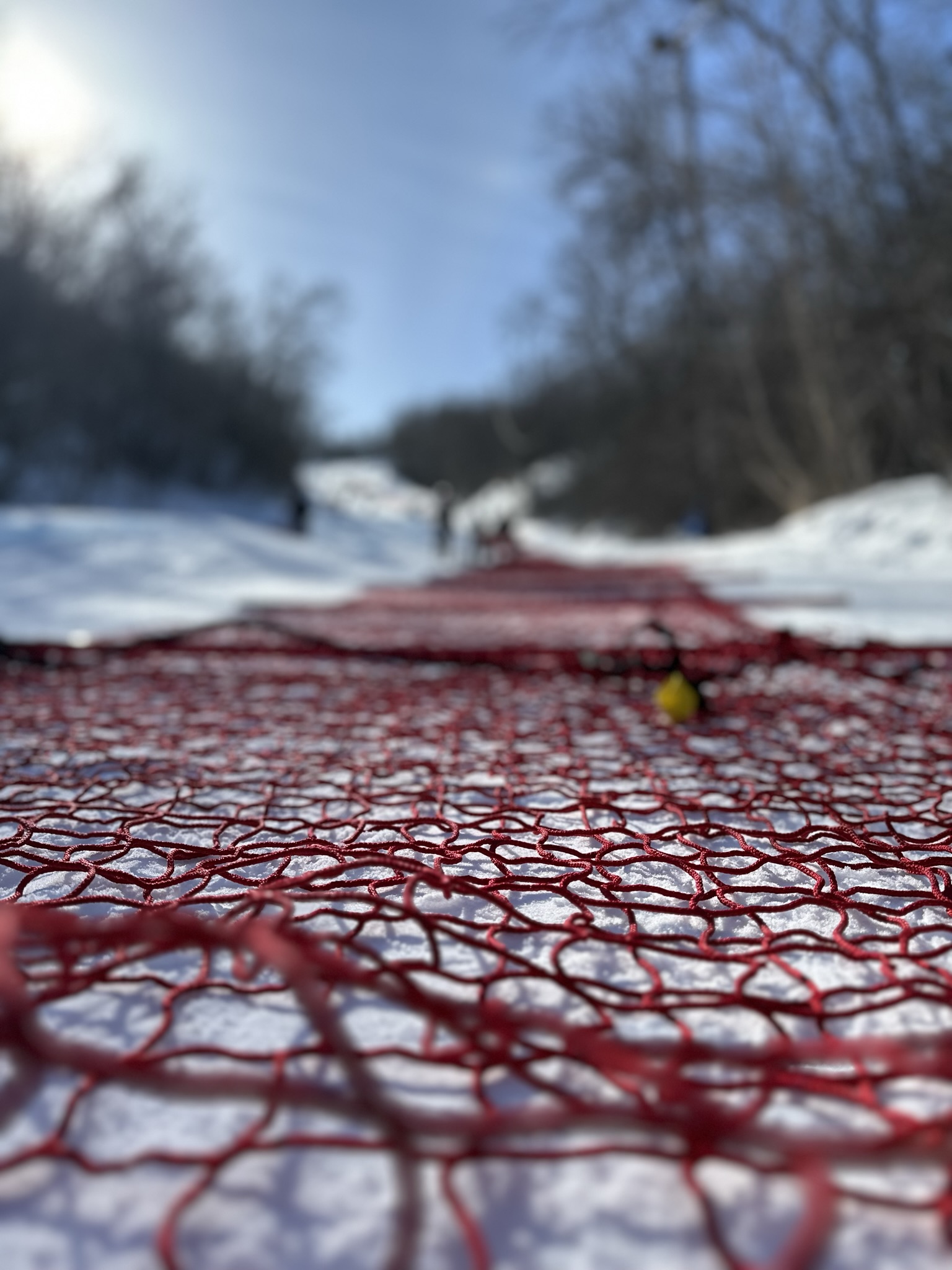Learn to Train
LEARN THE SPORT
In the learn to train stage, skiers are becoming ski racers while continuing to develop foundational movement and skiing skills in structured and unstructured environments. Ski racers in this stage are beginning to consolidate their foundational skiing skills while at play in free ski and ski racing environments in a variety of terrain. Ski racers are beginning to understand the tactics involved in ski racing as they learn more about the sport of ski racing in a fun and playful environment that promotes self-discovery.
Photo: Coach Neale Gillespie with a crew of aspiring ski racers. Martock Ski Club, 2018.
KEY CONCEPTS
The primary goal, in the Learn to Train stage, is to develop solid technical skill execution in all situations and environments at varying speeds while having fun. Young ski racers can begin to understand the use of dynamic, athletic turns in a variety of training environments. Ski racers participate in local club races exposing ski racers to all disciplines of ski racing including dual and ski cross kombi events. Ski racers are encouraged to explore the mountain and begin to take more responsibility for their development through self-discovery.
THE GOAL IS TO MAXIMIZE THE NUMBER OF DAYS AND TIME ON SKIS WHILE FOSTERING THE LOVE OF SKIING.
Providing positive feedback and ongoing encouragement as often as possible will increase the experience for every child.
- Encourage young ski racers to further develop their fundamental movement and technical skiing skills.
- Encourage participation in complementary sports when not skiing. It's important that young ski racers do not specialize too early.
- Encourage unstructured play.
- Encourage young ski racers to develop their endurance by playing games where they move continuously for longer time periods.
- Make sure young ski racers participate in strength building sessions using their own body weight, working with medicine balls, Swiss balls, hopping and bouncing.
- Young ski racers can develop speed through activities that focus on rapid, darting movements and on fast hand and foot movements. Rapid changes in direction are also encouraged in the form of playing tag.
LTAD PARENT TIPS
|
General |
Being fit becomes more important in the development of young ski racers. Continue to encourage unstructured play along with complementary sport participation to develop overall athleticism. |
|---|---|
|
Coaching |
Hire only trained or certified coaches and instructors who follow the ACA LTAD guidelines. |
|
Equipment |
Ensure all equipment is properly fitting, skis are tuned and waxed, boots are the proper size and warm clothing is provided to ensure the best opportunity for success. Click on the equipment tab for more details. |
|
Family |
Alpine skiing is a true family sport that embraces the whole family, not just the athlete. Many friendships that last a lifetime are built at the ski hill through ski club functions and getting involved in the local club events. |
|
Building Athletic Character |
Be aware of your young ski racers self-talk and self-esteem. Guide them to establish a growth mindset through your words and behaviour as a mentor. Continue to instill a passion for skiing. |
|
Training & Competition Volumes |
Time on snow is a precious commodity during the winter months. Children should aim to complete more than the minimum number of suggested days on snow because time and mileage on snow in the early years is more difficult to replace in the later stages of development. Young ski racers should aim to ski as often as possible when the ski areas are open. Aiming for a minimum of 60+ days per year or skiing. Skiing two to three times per week is optimal for developing proficiency in fundamental skiing skills. The number of competition starts ranges from 8 to 12 starts per season. Competitions should be fun, skill-based, and in a sprint format where young skiers can take as many runs as possible. Typical events include giant slalom, slalom, dual/team events, speed elements, Kombi SX/SG, Kombi GS/SG, Kombi GS/SL, obstacle courses, mogul and free ski competitions, and skill events. |
|
Physical Literacy |
Skiers consolidate their fundamental movement skills during this stage. Proper development of the fundamental movement skills allows the ski racers to excel in ski racing and the various complementary sports that support the development of their athletic abilities throughout their skiing career. Our ski racers need to be physically fit and literate in a broad range of sporting environments. The responsibility for developing physically fit and literate ski racers ultimately resides with the parents and guardian in partnership with their coaches and local ski club. |
|
Choosing a Club |
One of the most important decisions you will make during the early stages of your child's' development will be determining which club to join. Use the information in the next section to assist in choosing your ski club. |
|
Health & Wellness |
Ensure young children are maintaining their health and wellness including sleep, nutrition, hydration, time on task, etc.. Maintain a good balance between sport, family, education and social activities. The time spent travelling to/from the ski hill and at the ski hill can be long. Consider bringing snacks, water, etc. to ensure your child is properly fueled. |
CHOOSING A CLUB
Choosing a club that fits your family is one of the most critical decisions. Here are some sample questions to use when researching the best organization for you and your ski racer.
- Are the coaches certified in the National Coaching Certification Program?
- What coaching experience do they have and at what levels?
- Do they have reasonable short and long-term goals?
- Has the club taken the Responsible Coaching Movement pledge?
- Do they have secure 'Safe in Sports Policies'?
- Do they follow the ACA LTAD guidelines?
- What is the overall reputation of the club for providing a quality sports environment for ski racers at the Learn to Train stage?
- Does the program emphasize the proper development of fundamental movement and foundational technical skiing skills?
- Do they provide an off-season conditioning program? Do they work with complementary sports clubs to promote the development of physical literacy? Is there an increased cost for this service?
- Do they participate in annual fitness testing?
- What is the club reputation amongst parents of current athletes?
- How many days on snow (volume) is available to your child and is it consistent with the ACA LTAD recommendations for the Learn to Train stage?
- What is the cost? Volunteer expectations?
- What is the driving time to the hill (proximity)?
- Do they host a pre-season equipment purchase event with knowledgeable coaches and technicians present to assist with proper equipment selection?
- Is there an equipment pool available? Do they host an annual ski swap where lightly used equipment can be purchased?
- Are they committed to creating efficiencies for the parents and ski racers?
EQUIPMENT
The proper equipment set up and fit can help provide the young skier with a positive sports experience that gives the skier increased chances of having success with developing their fundamental skiing skills. Poorly fitting, improperly adjusted or un-tuned equipment can prevent a skier from successfully developing their fundamental skiing skills.
For more information on equipment selection, please review the following webisode aimed at selecting and fitting equipment for the U10 to U14 ski racer and work in partnership with your local club coach to ensure the ski racer has the best equipment set up to promote proper skill development and execution.
Alpine Canada Partners and Equipment Pool Suppliers
TO REVIEW EQUIPMENT REQUIREMENTS FOR THE LEARN TO TRAIN STAGE, PLEASE VISIT THE LEARN TO TRAIN EQUIPMENT PAGE.
MAINTAINING BALANCE & EDUCATION
While it is a challenge to raise active children and ski racers, it's not impossible to create a balance between participation in sports, family time, social time and education.Maintaining a balanced family life that fosters the development of healthy habits includes:
- Scheduling family time and activities where the family can be active together.
- Ensure that everyone in the family has time for rest and regeneration.
- Find a balance between school, sports, and encourage multisport exposure.
- Work in partnership with your young ski racer develops a simple monitoring routine to assist ski racers with their recovery between training and competition bouts.
- Allow for social "play" time with other ski racers and friends in an unstructured environment like the park playground or ski area.
- When ski racers begin to participate in a more structured sports program, parents should become involved through volunteer activities at their ski racer's local club.
- Encourage the use of a student planner or calendar to ensure a balance is maintained.
- Encourage the young ski racer to communicate with their teachers, parent communication should reinforce the student contact when necessary.
- Provide appropriate notice for school absences.
REFERENCES:
Adams, K. BC Alpine AGM Presentation: Education and Ski Racing - Finding a Balance
REFERENCES:
ACA LTAD Learn to Train Webinar
Webinar reviewing Selection & Fitting of Equipment for U10 to U14 ski racers
Sport for Life - Long Term Development in Sport & Physical Activity 3.0. Higgs, Colin & Way, Richard & Harber, Vicki, Jurbala, Paul, Bayli, Istvan. (2019). Long-Term Development in Sport and Physical Activity 3.0. Canadian Sport for Life. ISBN: 978-1-927921-62-3.
ACA LTAD Training and Competition Focus Matrix
ACA LTAD Training and Competition Volume Matrix


.jpg)


